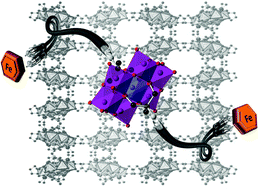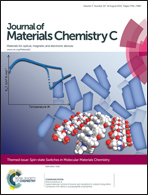Bimetallic MnIII–FeII hybrid complexes formed by a functionalized MnIII Anderson polyoxometalate coordinated to FeII: observation of a field-induced slow relaxation of magnetization in the MnIII centres and a photoinduced spin-crossover in the FeII centres†
Abstract
The synthesis and crystal structure of an Anderson POM functionalized with two 2,6-di(pyrazol-1-yl)-pyridine (1-bpp) ligands are reported (compound 1). High-frequency electron paramagnetic resonance (HF-EPR) and magnetic measurements show that it presents a significant negative axial zero-field splitting and field-induced slow relaxation of magnetization due to the presence of isolated MnIII anisotropic magnetic ions. Complexation of 1 with FeII gives rise to a 2D cationic network formed by Anderson POMs coordinated to two FeII ions through the two tridentate 1-bpp ligands and to other two FeII ions through two oxo ligands in compound 2, and to an anionic polymeric network formed by Anderson POMs coordinated through the 1-bpp ligands to two FeII, which are coordinated to two 1-bpp ligands from two neighbouring POMs, in compound 3. The crystal structure of 2 has been solved. Magnetic properties show that the FeII atoms of 3 remain in the low-spin state, while those of 2 remain in the high-spin state due to coordination to oxygen atoms from a neighbouring POM and dimethylformamide and water solvent molecules. Irradiation of 3 at 10 K with green light induces a spin-crossover (LIESST effect) with a small but significant photoconversion (∼8%). Finally, AC susceptibility measurements of 2, 3 and (C16H36N)3[MnMo6O18{(OCH2)3CNH2}2] (4) confirm field-induced slow relaxation of magnetization of MnIII Anderson POMs.

- This article is part of the themed collection: Spin State Switches in Molecular Materials Chemistry

 Please wait while we load your content...
Please wait while we load your content...